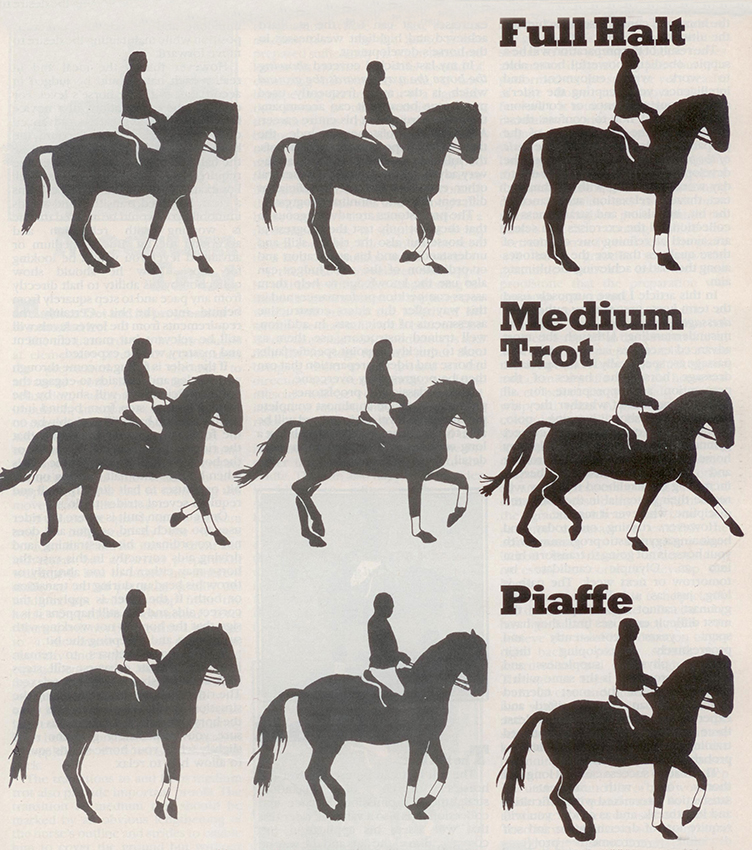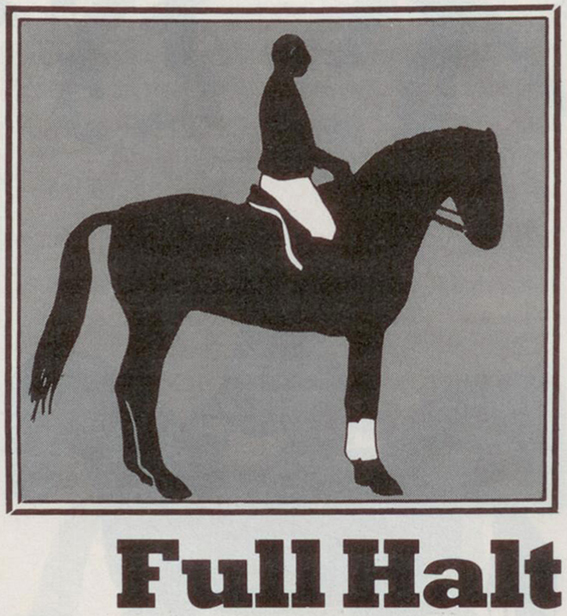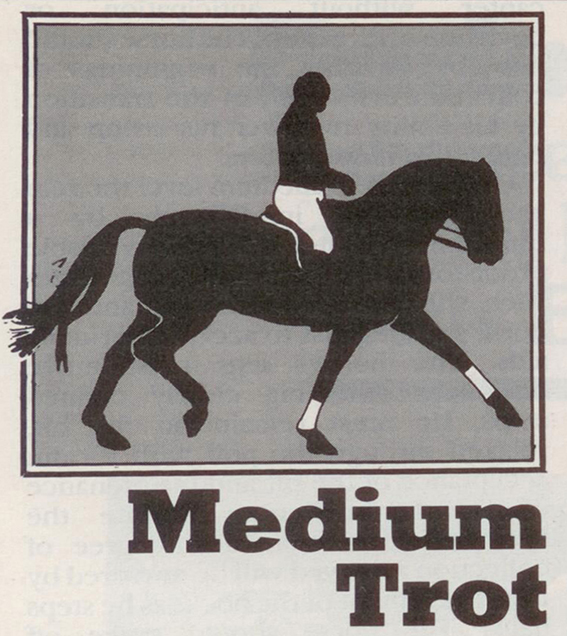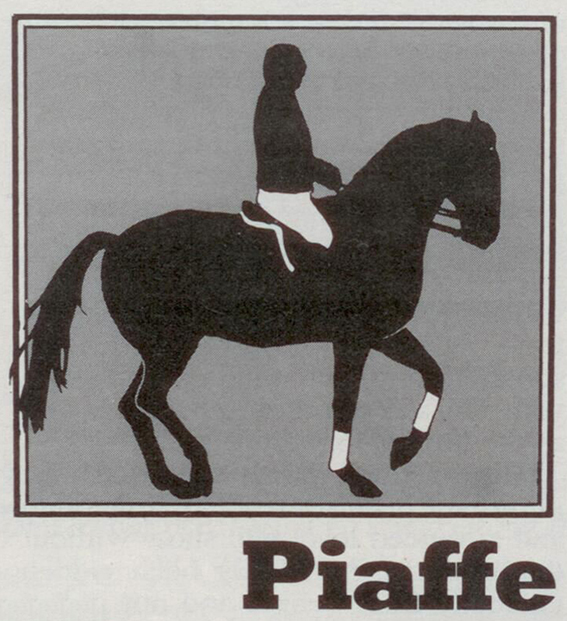by Christian Thiess
German trainer Christian Thiess has another fascinating series of tests to check the progress of your horse. Christian’s ‘proofstones’ are the result of a lifetime’s study of the art of dressage and a close adherence to the Classical Principles. We are sure that these exercises will improve any horse – your horse. Let Christian explain….
Have you ever stopped and pondered: What, exactly is the aim when I prepare my horse? This is a question I often ask my pupils, yet despite its importance, I rarely receive a correct answer.
Right now, stop reading for a moment and consider this question for yourself. Do you have a specific long term aim for your horse that you are working to achieve through your preparation, or are you vaguely stumbling along from day to day with your riding?
Maybe, like many people I meet you will answer that you have goals to successfully compete or to be able to ride more advanced movements like piaffe and passage. Or perhaps you simply with to transform your horse into a more enjoyable animal to ride. But all these answers show confusion between the personal ambitions of the rider and the exercises used to achieve the aim and by-products of the correct preparation. The real aim, although more long term, is to improve the natural abilities of the horse, which especially emphasizes refining his paces.
This aim can only be achieved through a correct gymnastic programme based around selecting the right exercises appropriate to the horse’s stage of development and executing these correctly. This is the essence of the classical equitation. So the long term goal is not to ride a leg yield, half pass, piaffe and so on, it is to ride those movements at the correct time, and in the right manner to build the gymnastic ability of the horse and come closer to achieving the ultimate aim.
The result of the preparation will be a supple, obedient, powerful horse able to work with enjoyment and intelligence, yet accepting the rider’s aids without resistance or confusion. But be careful not to confuse these results with the overall goal of the preparation. Also keep in mind the scale of the preparation which you should be developing progressively in your day to day work, beginning with rhythm and tact, through relaxation, acceptance of the bit, impulsion and straightness to collection. All the exercises you select are aimed at refining one or more of these qualities that are the milestones along the road to achieving the ultimate aim.
In this article I have purposely used the term horse preparation rather than dressage preparation to avoid any misunderstanding. Although the most advanced exercises such as piaffe and passage are specifically for the specialist dressage horse, the basics of the preparation are appropriate for all horses regardless of whether they are destined for show jumping, polo, eventing or otherwise. A correct gymnastic programme will help any horse become more supple, stronger and more responsive, thereby increasing the likelihood that they will realise their potential in their selected discipline, whatever it may be.
However, rushing out today and beginning a gymnastic programme with your horse is not going to transform him into an Olympic candidate by tomorrow or next week. The path is long, just as a ballerina or human gymnast cannot hope to perform the most difficult exercises until they have spent years consistently and progressively developing their strength, physique, suppleness and mental approach. It is the same with a horse and even the most talented animal with an equally gifted and experienced rider will take at least three to five years of concentrated training to achieve advanced level – probably a few years more.
The road to success can be a long and thorny one, with moments of satisfaction intermixed with difficulties and heartbreak, and as a rider you will require lots of determination and self-discipline to overcome the problems encountered. Along the way you will also need plenty of help including an attentive veterinary surgeon and farrier, a tactful and experienced instructor and constructive judges just to mention a few. However, you, as a rider, have the possibility of testing the results of your training programme at all levels. This is through the proof-stones, a series of exercises that can test the standard achieved and highlight weaknesses in the horse’s development.
In a previous article I covered showing the horse the way towards the ground which is the most frequently used proofstone because it can accompany the horse throughout his entire career. Additional proofstones include the three other important classical proofs: the full halt, medium trot and, at the very advanced level, piaffe, plus several other exercises that are beneficial at different stages to monitor progress.
The proofstones are advantageous in that they not only test the progress of the horse but also the rider’s skill and understanding and his application and co-ordination of the aids. Judges can also use the knowledge to help them assess competition performances and in this way offer the riders constructive assessments of their tests. In addition, well-trained instructors use them as tools to quickly pinpoint specific faults in horse and rider’s preparation that can then be progressively overcome.
The classical proofstones, in particular, provide an almost complete picture of the level achieved and will be able to accompany you and your horse a long way. Let us look at them in more detail.
The full halt can be used to test the horse’s degree of relaxation, straightness, submission, balance and collection. It is also a valuable rider test that will assess his application and co-ordination of the aids and the way he influences the horse. Ideally the horse should step smoothly and directly into halt and clearly show in the transition his ability to step from behind into the bit. This is the most important feature that should be looked for.
The halt should be square with the horse’s weight equally distributed over his four legs. He should remain immobile and relaxed in a collected position while maintaining the desire to move forward.
However this is the ideal and in reality each halt should be judged in accordance with the horse’s level. For example the expectations of a novice horse will not be as great as an advanced one. But by taking into account the horse’s stage you will be able to analyse the halt and test if he has mastered the requirements appropriate to his level. For example if a novice horse performs a clear, balanced transition and stands immobile you would be assured that he is working with relaxation and accepting the bit. But at medium or advanced level you would be looking for more. Now he should show collection by his ability to halt directly from any pace and to step squarely from behind into the bit. Certainly the requirements from the lower levels will still be relevant but more refinement and mastery will be expected.
If the rider is failing to come through with his leg and seat aids to engage the horse sufficiently it will show by the horse failing to step from behind into the bit and the halt will probably be on the forehand. Another indication that the rider is not engaging the horse or the horse is refusing to accept the aids is when he runs into halt, bearing on the bit, or refuses to halt directly at all and requires several strides to do so.
One common fault is where the rider uses too much hand or spur and does not co-ordinate his restraining and driving aids correctly. In this case the horse may either halt too abruptly or throw his head up during the transition or both. If the rider is applying the correct aids and this still happens it is a sign that the horse is not working with submission and accepting the bit.
If the horse refuses to remain immobile, falls in, or worse still, steps back at halt it shows he is not relaxed. The rider may also be antagonizing the situation by not relaxing his aids once the horse has halted. To avoid this make sure you immediately give the reins slightly when your horse stands square to allow him to relax.
MEDIUM TROT AND ITS PROGRESSION TO EXTENDED TROT
The medium trot can be introduced at elementary level and accompanies the preparation right through to advanced work It tests for rhythm, relaxation, acceptance of the bit, impulsion, straightness and the degree of engagement of the hindlegs. It will also highlight the rider’s ability to co-ordinate the driving and restraining aids, his degree achieved in generating impulsion, plus the relaxation and suppleness of his seat in following the movement of the horse.
Of course the quality of the medium trot is influenced by the horse’s conformation and his natural talent and movement but a correct preparation will enable him to utilise his inherent ability to its full potential. Ideally the medium trot will develop from the horse’s first efforts at elementary level where it will not be as refined, through to a movement full of expression, elasticity and impulsion. The relaxed engagement of the hindquarters will free the shoulders and allow the horse to stride rhythmically forward with calm acceptance of the bit. The overall impression will be of power originating from behind combined with relaxation exemplified by the horse’s soft swinging back.
The transitions to and from medium trot also provide important proofs. The transition to medium trot should be marked by an obvious lengthening of the horse’s outline and strides to enable him to cover the ground but without any alteration of his tact and rhythm. When asked to come back to collected or working trot the horse should show his obedience, suppleness and acceptance of the aids by willingly compressing his frame and shortening his strides, again while maintaining the rhythm and tact.
A common fault often seen in competition where the test requires medium trot · but the horse is not prepared sufficiently · is when the horse looses his rhythm and runs instead of extending his strides. Little, if any, lengthening occurs and it is a sign that the horse is not established and therefore has not developed the balance and impulsion to show medium trot. The previous work must be mastered before the horse is equipped for this level. Sometimes, though, it is an indication that the rider is not coming through with his aids and although the horse may have the ability to perform a medium trot he is simply not being ridden correctly. This can also be seen by a lack of impulsion in the work.
If the horse is not relaxed and supple he will have difficulties lengthening his frame in the transition to medium trot which will restrict the length of his strides. He may hollow his back or if he is very tense take stiff, wooden steps and flick the forelegs forward rather than bringing them to the ground in the direction they were pointing. His back muscles will be contracted and rigid instead of relaxed and swinging so the rider will have difficulty sitting.
Riders who use too much hand may find their horses drop behind the bit rather than reaching forward into the bridle. This can also happen if the rider is failing to influence the horse sufficiently with his driving aids or if the horse is not accepting the bit.
Medium trot and its progression to extended trot can also show how well the rider’s feel is developed to the degree of knowing how much the horse is able to give. When the rider asks for too much the horse is likely to lose rhythm and become tense or fall on the forehand and run.
Piaffe is the pinnacle of collection required in dressage competition and the highest of the schools of the ground and the foundation for all schools above the ground. It is a two-time movement similar to trot in that the horse moves alternative diagonal leg pairs but it is performed on the spot (or very nearly, as the horse may move slightly forward). It is important that the horse maintains correct cadence (well defined tact with plenty of impulsion) with maximum engagement of the hindlegs which will cause a lowering of the croup and a relative elevation of the forehand. There must be no diminishing of the impulsion and the poll must remain the highest point without the horse’s faceline coming behind the vertical. Correctly executed the piaffe will be a graceful yet powerful gymnastic exercise and the best proofstone that the preparation was thorough and correct.
It is important to be able to distinguish between a piaffe that has evolved correctly at the advanced level as a result of the preparation, like a fruit that is ripe and ready to be plucked, and a mechanical piaffe where the horse was forced before he was ready with the whip and spurs. A piaffe done under compulsion will be tense and spasmodic, the horse’s back will be stiff and he will be restricted in his movement. The horse’s incorrect preparation will be apparent in all other advanced exercises too and is a result of either the horse being rushed through the grades without the time and patience necessary to establish the achievements, or the rider/trainer lacked the classical understanding necessary to correctly develop the horse.
Let’s take an example to help clarify the difference. Imagine a Doctor who has specialised in neurosurgery. To achieve this level his education began right back at primary school, then intermediate and on to high school. Throughout these years his studies were diverse and aimed at providing him with a good basic understanding and an introduction to the self-discipline required to assimilate knowledge. But this was only the beginning, like the correctly prepared horse at elementary level. The next step was university and lots of hard work and study to gain qualifications in general medicine to be recognised as a doctor. Then he was similar to our young horse working through medium level and the beginning of advanced work. But for our doctor a general medical qualification was still not enough to become a specialist neurosurgeon. Providing he had the intelligence, determination and self-discipline to learn, more study, more hard work, more practical experience day and night in the hospitals was required. He began to diagnose and assist in operations, and sat more examinations until gradually, after years and years of consistent work, he became a top specialist in neurosurgery. All his years of training are expressed in his performances at the operating table and in being able to accurately diagnose patients.
It is the same with the horse at piaffe – for the true piaffe is an expression of the correct and thorough preparation that has come before it.
But now imagine someone else who has only had a superficial education but who acquired a position with a company selling equipment to the hospital where our neurosurgeon works. The seller needs to be able to talk about the brain and nerve functions in the human being to sell his product so he read a medical book and attempted to memorize the information and terminology, and in this way gained a little shallow knowledge. A layman listening to the doctor and the salesman talking may consider both have an understanding of the subject … but can you really compare? Behind the doctor’s words are years of learning, experience and refinement – whereas the seller is like a parrot. The salesman may know a little of the terminology from the text book but he does not have an understanding or awareness of neurosurgery.
And it is the same with our two horses, for only the animal with the correct preparation will be capable of performing a true piaffe that embodies all the development that has come before. Only this horse will, as a result of his gradual progressive development, be able to show the refinement of his natural abilities and the purity of his paces. The correct progression of gymnastic exercises will have equipped him, whereas the other horse without the classical education will only provide a poor mechanical imitation of the piaffe and other advanced movements. He will only fool the people who do not understand the true aims of the training.
A horse trained by compulsion, or without understanding or time to become established will be exposed by the proofstones, especially at advanced level by his inability to show extended walk, medium trot or to find the way towards the ground.
At the other levels there are several exercises appropriate for shedding light on progress. At novice grade the leg yield at walk shows if the horse is able to bend and load the hindlegs, as well as his response to the rider’s lateral driving aids and his acceptance of the outside rein. The rider can use the exercise to check if he is coming through with his aids and is able to influence the horse.
On the way to elementary level the transitions, especially downwards, provide accurate information on the rider’s skill in correctly co-ordinating his forward driving and restraining aids. They also highlight the horse’s obedience and acceptance, his durchlassigkeit, which can be loosely translated to whether the aids permeate and influence the horse without becoming blocked or diminished in their effectiveness. The aids must flow through the entire horse without meeting resistance.
At elementary level when the demands for relaxation, rhythm, even contact, impulsion and straightness grow the simple canter change on the centre line is a more exacting proofstone. The horse should show a direct, soft transition from canter to walk with a clear engagement of the hocks and lowering of the croup. No trot strides should be seen and the walk should be relaxed and well defined.
After two, or at most three, walk steps the horse should strike off directly into canter without anticipation or deviation of direction. The horse should now be showing the beginnings of collection evidenced in the transition by his ability to lower his croup and engage his hindquarters.
On the way to medium level the rein back followed immediately by a transition to canter is another valuable proofstone. The even and straight rein back will test for relaxation and the horse’s willingness to accept the rider’s aids. The horse’s legs must move diagonally with big clearly defined steps. He must remain on the bit, relaxed through the poll with a calm acceptance of the bit and maintenance of the forward urge despite the backwards direction. The degree of collection achieved will be mirrored by the engagement of the hocks as he steps back. The horse should strike off directly to canter when asked without hesitation or intermediate steps. The transition will test the straightness and the readiness of the hindquarters to take the weight. The rider should be able to maintain the collection throughout with invisible aids.
At advanced level the expectations for the correct execution of all the exercises will be increased but if the demands of the scale of preparation have been correctly fulfilled this is a normal consequence. However, there are still exercises to test the higher requirements, for example the single sequence canter changes will prove if the horse is really straight and able to jump under and develop maximum impulsion with the collection. It is a test of the horse’s suppleness and obedience, and the co-ordination of both horse and rider.
Transitions from lateral movement to lateral movement will highlight the level of suppleness, straightness, impulsion and collection achieved. The horse should now accept the aids with total harmony – evidenced by his willingness to alter his position fluently from exercise to exercise. The shoulder-in followed immediately by a volte will also test these qualities as well as the horse’s forward urge.
The extended walk is one of the most important proofstones, and at medium and advanced level will show without doubt if the horse has been ridden correctly from behind and not pulled together. The horse must be able to stretch his neck and back muscles and seek the bit while still engaging the hindlegs and stepping purposely forward. The strides should cover the maximum amount of ground with even, industrious steps. So often the extended walk is the most obvious failing in advanced competition performances. Whereas in other movements imperfections can be partially concealed from all but the best trained eyes, the extended walk can be glaring with loss of rhythm, jogging, contracted frame, hesitancy, failure to accept the bit and throwing of the head to name just a few faults commonly seen.
Any rider who is unable to develop correct work at this level needs to seriously consider his methods and especially his concept of the preparation. Are his aims in line with what is best for his horse – aims that have been developed and proven over centuries by thousands of horsemen? Or is a radical rethink of his entire approach necessary?
The proofstones themselves have stood the test of time and provided invaluable help in the schooling of hundreds of thousands of horses. They have been proven effective, and used by discerning riders they will continue to offer beneficial guidance in the course of working towards achieving the ultimate aim … to improve the natural abilities of the horse.
This article originally appeared in the October 1985 edition of The Horse Magazine.
For more from Christian Thiess go here:






What an interesting man.